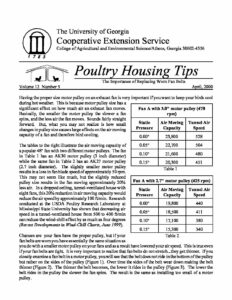Having the proper size motor pulley on an exhaust fan is very important if you want to keep your birds cool during hot weather. This is because motor pulley size has a significant effect on how much air an exhaust fan moves. Basically, the smaller the motor pulley the slower a fan spins, and the less air the fan moves. Sounds fairly straight forward. But, what you may not realize is how small changes in pulley size causes large effects on the air moving capacity of a fan and therefore bird cooli...ng.
The tables to the right illustrate the air moving capacity of a popular 48" fan with two different motor pulleys. The fan in Table 1 has an AK30 motor pulley (3 inch diameter) while the same fan in Table 2 has an AK27 motor pulley (2.7 inch diameter). The slightly smaller motor pulley results in a loss in fan blade speed of approximately 50 rpm. This may not seem like much, but the slightly reduced pulley size results in the fan moving approximately 20% less air. In a dropped ceiling, tunnel-ventilated house with eight fans, this 20% reduction in air moving capacity would reduce the air speed by approximately 100 ft/min. Research conducted at the USDA Poultry Research Laboratory at Mississippi State University has shown that decreasing air speed in a tunnel-ventilated house from 500 to 400 ft/min can reduce the wind-chill effect by as much as four degrees (Recent Developments in Wind-Chill Charts, June 1999).
Chances are your fans have the proper pulley, but if your fan belts are worn you have essentially the same situation as you do with a smaller motor pulley on your fans and as a result have lowered your air speed. This is true even if your fan belts are tight. It is very important to realize that fan belts do not stretch...they get thinner. If you closely examine a fan belt in a motor pulley, you will see that the belt does not ride in the bottom of the pulley but rather on the sides of the pulley (Figure 1). Over time the sides of the belt wear down making the belt thinner (Figure 2). The thinner the belt becomes, the lower it rides in the pulley (Figure 3). The lower the belt rides in the pulley the slower the fan spins. The result is the same as installing too small of a motor pulley.
How do you know if your belts are worn? A new belt should be able to be seen over the sides of the motor pulley (Figure 4). If the belt is flush with the top of the motor pulley it probably needs to be replaced. If the belt is riding low in the pulley, such as in Figure 3, the belt is in definite need of replacing. You will find that in a modern tunnel-ventilated poultry house that the belts need to be replaced around once a year. But, belts that are not properly tensioned when installed may not even last this long. Many growers wisely make it a policy to replace all their tunnel fan belts each spring before hot weather arrives.
Another factor to consider is that if you allow a loose belt to remain on a fan, the slipping of the belt over the motor pulley will cause excessive wear on the pulley. As a result the motor pulley becomes more “U” shaped
rather than “V” shaped. When this happens even a new belt will not ride in the pulley properly resulting in reduced air moving capacity of the fan. This problem can only be solved by replacing the motor pulley.
One last point, do not put a larger pulley on a fan than what is specified by the manufacturer. Though it is true that the fan will move more air, the problem is that the power usage of the fan increases dramatically
which can lead to the “burning out” of the fan motor.
Details
| Year | Volume | Number | Categories |
|---|---|---|---|
| 2000 | 12 | 5 |

